
Friday morning we went to see the gardens at Filoli, an estate between San Jose and San Franciso near Woodside, CA. The first view of the gardens, shown above, is perhaps the most impressive. You step through an arched door in a brick wall and there lies—arcadia. Another world. The square-trimmed trees in the background give it an especially magical look.

I reflexively tend to think of viewing gardens as being boring, but it was definitely worth the trip—although it’s good to get there early before the people overwhelm the nature. I’ll be using some more Filoli pictures in coming posts.
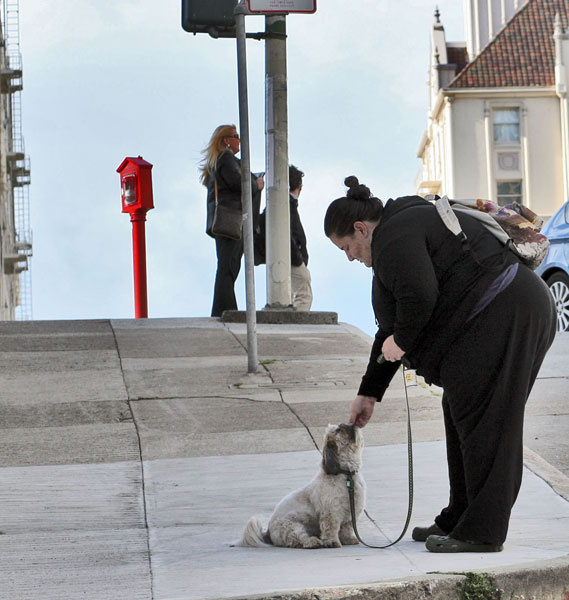
We spent a couple of nights in San Francisco, for the Easter weekend, staying on Nob Hill, atop extremely steep streets coming up from Union Square. I saw this great woman giving her dog a treat on the way up.
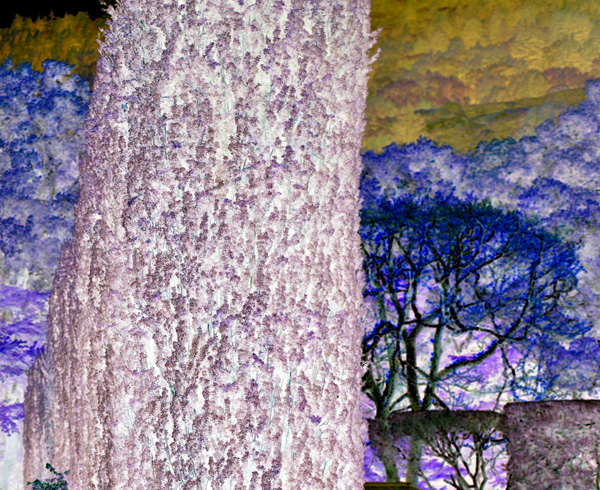
I picked up a fresh copy of Wm. Burroughs, The Soft Machine, at City Lights Books, with a nice pink cover, and reread some of it. Long time no see. Its chapters seem fairly independent of each other. Some aren’t too badly cut-up. One chapter I read, like dada pulp SF, “The Mayan Caper,” gives me some ideas for how things might be in Flimsy. A few quotes.
Setting up for time travel to Mayan times. “Then he injected a blue fluid of heavy cold silence as word dust fell from demagnetized patterns—from a remote Polar distance I could see the doctor…”
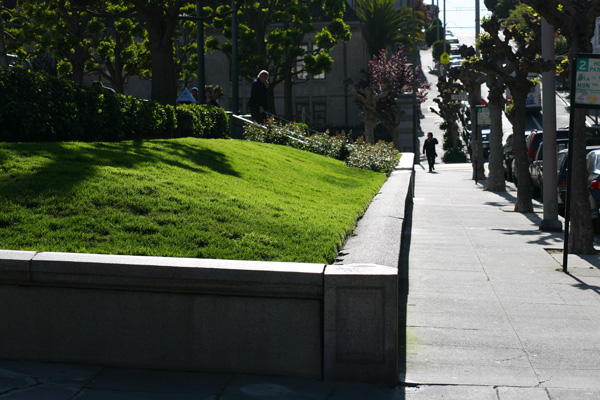
After the transition. “Suddenly he sat up talking in Mayan—The word curled out his mouth and hung visible in the air like vine tendrils—I felt a strange vertigo which I recognized as the motion sickness of time travel…” Note that Burroughs uses that same phrase, “the motion sickness of time travel” in Yage Letters, to describe the nausea prouduced by the psychedelic yage vine drug.
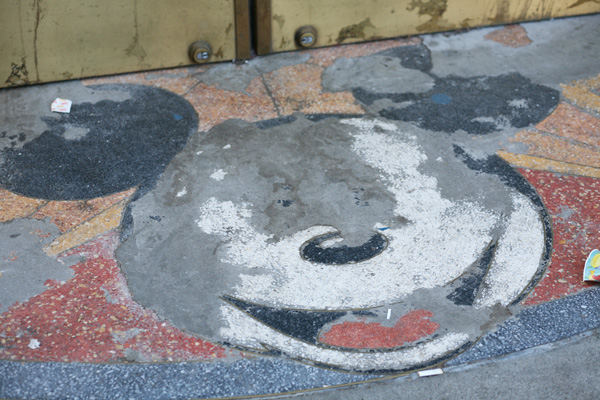
[A rubbed-out Mickey Mouse logo on the sidewalk outside the now-defunct Disney store. Sign of the times.]
“I lay down in the hammock and immediately felt the stabbing probes of telepathic interrogation.” That’s a classic SF phrase, takes me back to the Andre Norton books I read as a boy.
At the frequent celebrations, “…the priests appeared in elaborate costumes, often disguised as centipedes or lobsters…”
“I made recordings of the festivals and the continuous music like a shrill insect frequency that followed the workers all day in the fields.”
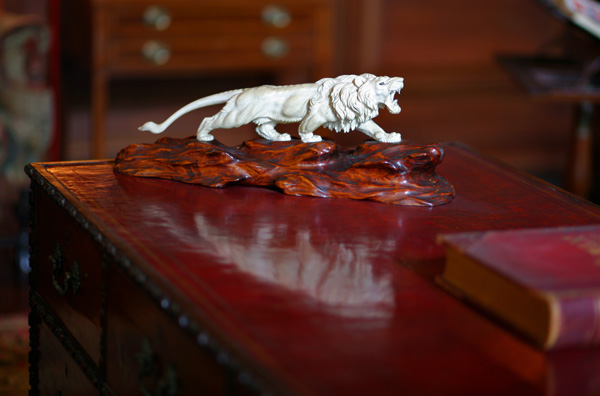
[An ivory cougar in the Filoli mansion.]
Burroughs loved the idea of altering reality with cut-up sound and music. As it happens, while I was in SF, I had a chance to talk to an old friend, Jack Vad, who is a sound tech for the SF Symphony Orchestra.
Jack said, “Being a sound tech can be like being a dental hygienist or like being a sculptor.” Sometimes he’s just tweaking and cleaning, sometimes he’s molding sounds. He has really good software, it got a lot better in the last two years. He used the word “detune” to mean change the pitch. For fixing a sour note, you used to have to detune all the instruments, and had trade-offs where fixing one was messing up the others. But now the soundware lets you isolate a particular line of music, an individual instrument, and detune that alone.
Not all that great a step from this to Burroughsian reality control with your sound chip…
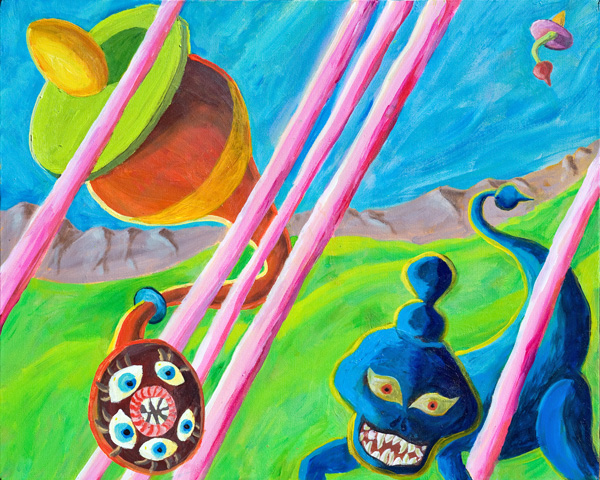
[My recent painting, “The Flims,” showing a jiva on the left and a yuel on the right.]
I’d been hung-up trying to figure out what things are like in this world Flimsy where my character Jim goes in my novel-in-progress Jim and the Flims.
So now, under the aleatory influence of The Soft Machine, I’m thinking of Flimsy as a slave society. And that it’s those seemingly pleasant jivas running things—even though they look like fairly benevolent flying turnips. The jivas are the controllers in Flimsy.
So the nice-seeming jivas are bad. Conversely, the scapegoat yuels are in fact rather neutral about us, and even at times goodhearted. And at some point our hero Jim finds this out.
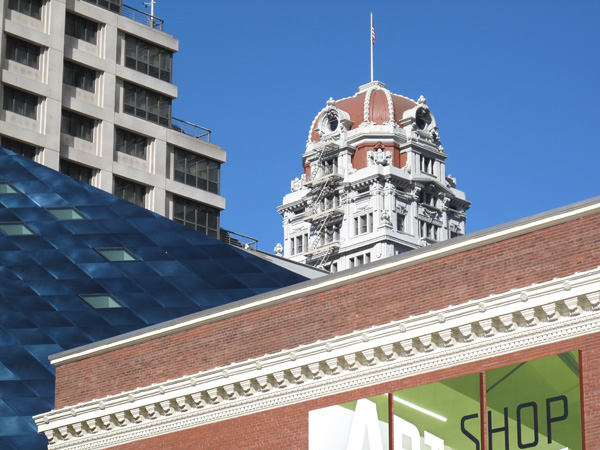
I think of this kind of plot-twist as a flip. I did a flip in Spaceland, with the Kluppers and Dronners. At some point Jim will be captured by the yuels and learn how to talk with them, and then he’ll learn the truth—this moment is the reveal. Joe Cube got his reveal in Spaceland when he finally talked to a Dronner.
I see the bad jivas as objective correlative for a pocket computer, like an iPod or Blackberry—they glom onto you and give you power and link you in, but they control you.
The yuels don’t talk like we do, they use exclusively telepathic glyphs. Jim’s dog befriends a yuel. A yuel is an objective correlative for an emergent hive behavior.









April 14th, 2009 at 11:25 am
Publishing images of mentally ill people is not really cool.
Just saying.
April 14th, 2009 at 12:44 pm
jp, I would not say that man was mentally ill. But, okay, you’ve (successfully) guilt-tripped me. I’ll swap in a different image in place of the picture of that man freaking out..I include a “censored” version of the old picture here for reference (with the guy’s face blacked out). I liked the composition of the picture, and maybe the fact that the guy’s frantic behavior frightened me made me want to box him up in a photo.
This raises the whole issue of street photography. It IS legal to take people’s picture on the street and post these pictures (as long as you don’t add on libelous comments about the subjects). I didn’t used to quite understand that street photogrpaphy is fully legal. And you do NOT have to get permission from your subjects. If you’re in a public place, your appearance is public information.
But sometimes you wonder if you’re being exploitative or unethical, which was the point you were getting at. It IS kind of cheap to shoot picture of homeless people, or people who are completely out of it.
This said, I am interested in doing more street photography, such as the picture in today’s post of the woman feeding a treat to her dog.
Here’s two discussions of the ethics (and techniques) of street photography, one on photo.net:
http://photo.net/street-documentary-photography-forum/00DbJ1
And one on Flickr:
http://www.flickr.com/groups/candidphotos/discuss/72157613784356742/
April 16th, 2009 at 11:52 am
Now you made me feel guilty! Didn’t mean to make you use your time feeling guilty.
To me that guy is just in his own private world – even if he is in a public space.
Anyway, you taking a picture of him has got to be the least of his problems.
April 16th, 2009 at 12:35 pm
jp, you’ve never had your shirt suddenly fill up with bees or ants? Happens to me at least twice a week. The worst is when you get an octopus in your shoe.
April 17th, 2009 at 8:53 am
I think it is possible to take photos of street people and or persons suffering from various mental aberrations and still be ethical and compassionate about it. I think Diane Arbus was able to do so.
April 17th, 2009 at 9:03 am
Thanks, Roy. Diane Arbus is surely the saint of street photography, but she is a hard one to emulate. I think she’d get to know her street subjects personally, hang out with them, spend time with them, form a relationship. An amateur or hobbyist photographer isn’t likely to make the commitment it takes to acheive the two-way link between subject and photographer that you see in Diane’s photos.
If you’re shooting through a zoom lens, street photography can be like wildlife photography. Of course since it’s people, there’s an unsavory surveillance aspect here. But, after all, we’re always looking at other people out in public, it’s something we like to do.
When I do muster the courage to alert someone that I want to take their picture, I think it does tend to be more interesting. But, if done with the right touch and a good heart, an unobserved shot can work very well.
April 21st, 2009 at 8:31 am
Re: Yage
Yes, it has been argued that Burroughs less-than-nice Yage experiences were the source of inspiration for the composite city and many of the nightmarish visions of his later books
http://ayadoc.blogspot.com/2009/03/writers-and-ayahuasca-1-william.html
Here´s a recently unearthed documentary about Yage narrated by Burroughs
http://ayadoc.blogspot.com/2009/03/first-ayahuasca-documentary-redux.html